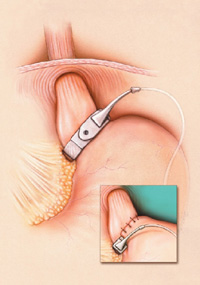WEIGHT LOSS SURGERY WITH THE LAP-BAND® SYSTEM
Approved by the FDA in June 2001, LAP-BAND System is the safest, least invasive and only adjustable surgical treatment for morbid obesity in the United States. It induces weight loss by reducing the capacity of the stomach, which restricts the amount of food that can be consumed. Since its clinical introduction in 1993, over 200,000 LAP-BAND procedures have been performed around the world.
View our Lap-Band video and feel confident we offer the safest bariatric procedures available.
Minimally Invasive Approach

During the procedure, surgeons usually use laparoscopic techniques (using small incisions and long-shafted instruments), to implant an inflatable silicone band into the patient’s abdomen. Like a wristwatch, the band is fastened around the upper stomach to create a new, tiny stomach pouch that limits and controls the amount of food you eat.
This system also creates a small outlet that slows the emptying process into the stomach and the intestines. As a result, patients experience an earlier sensation of fullness and are satisfied with smaller amounts of food. In turn, this results in weight loss.
Safest and Least Traumatic Procedure
Cypress Bariatric & General Surgery offering the safest and least traumataic procedures. Cypress Weight Loss offering LAP-BAND System surgery, gastric bypass surgery, lap band weight loss surgery, lap band procedure, lap band gastric surgery. Since there is no cutting, stapling or stomach re-routing involved in the LAP-BAND System procedure, it is considered the safest and least traumatic compared to other weight-loss surgeries. The laparoscopic approach to the surgery also offers the advantages of reduced post-operative pain, shortened hospital stay and quicker recovery. If for any reason the LAP-BAND System needs to be removed, the stomach generally returns to its original form.
Adjustable Treatment

The LAP-BAND System is also the only adjustable weight-loss surgery. The diameter of the band is adjustable for a customized weight-loss rate. Your individual needs can change as you lose weight. For example, pregnant patients can expand their band to accommodate a growing fetus, while patients who aren’t experiencing significant weight loss can have their bands tightened.
To modify the size of the band, its inner surface can be inflated or deflated with a saline solution. The band is connected by tubing to an access port, which is placed well below the skin during surgery. After the operation, the surgeon can control the amount of saline in the band by entering the port with a fine needle through the skin.
The LAP-BAND® System Advantage
The following is as easy to grasp summary of the advantages of the LAP-BAND System:
- Least invasive surgical option
- No intestinal re-routing
- No cutting or stapling of the stomach wall or bowel
- Small incisions and minimal scarring
- Reduced patient pain, length of hospital stay and recovery period
- Significantly lower mortality risk compared to other obesity surgeries1
- Low risk of nutritional deficiencies associated with gastric bypass
- Reduced risk of hair loss
- No “dumping syndrome” related to dietary intake restrictions
- Allows individualized degree of restriction for ideal, long-term weight loss rate
- Adjustments performed without additional surgery
- Supports pregnancy by allowing stomach outlet size to be opened for increased nutritional needs
- Removable at any time
- Stomach and other anatomy are generally restored to their original forms and functions
- More than 200,000 LAP-BANDs placed worldwide
- Standard of care for hundreds of practices around the world
- Academic publications with up to 9 years of follow-up
1. Executive summary: Laparoscopic adjustable gastric banding for the treatment of obesity (Update and Re-appraisal). The Australian Safety and Efficacy Register of New Interventional Procedures – Surgical (ASERNIPS) 2002; 1. (Laparoscopic adjustable gastric banding surgery, like the LAP-BAND surgery, is associated with a mean short-term mortality rate of around 0.05% compared to 0.50% for Gastric Bypass and 0.31% for Vertical Banded Gastroplasty.)
